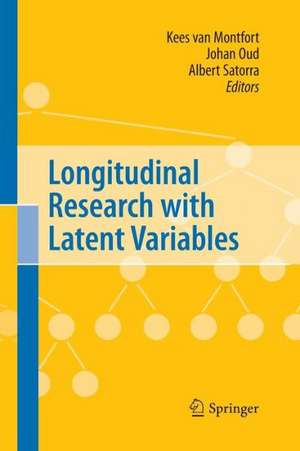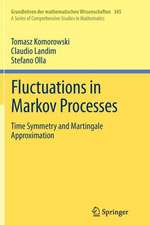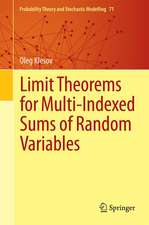Longitudinal Research with Latent Variables
Editat de Kees van Montfort, Johan H. L. Oud, Albert Satorraen Limba Engleză Paperback – noi 2014
| Toate formatele și edițiile | Preț | Express |
|---|---|---|
| Paperback (1) | 641.38 lei 6-8 săpt. | |
| Springer Berlin, Heidelberg – noi 2014 | 641.38 lei 6-8 săpt. | |
| Hardback (1) | 646.62 lei 6-8 săpt. | |
| Springer Berlin, Heidelberg – 25 mai 2010 | 646.62 lei 6-8 săpt. |
Preț: 641.38 lei
Preț vechi: 754.56 lei
-15% Nou
Puncte Express: 962
Preț estimativ în valută:
122.73€ • 131.24$ • 102.33£
122.73€ • 131.24$ • 102.33£
Carte tipărită la comandă
Livrare economică 18 aprilie-02 mai
Preluare comenzi: 021 569.72.76
Specificații
ISBN-13: 9783642425721
ISBN-10: 3642425720
Pagini: 316
Ilustrații: XI, 301 p.
Dimensiuni: 155 x 235 x 17 mm
Greutate: 0.45 kg
Ediția:2010
Editura: Springer Berlin, Heidelberg
Colecția Springer
Locul publicării:Berlin, Heidelberg, Germany
ISBN-10: 3642425720
Pagini: 316
Ilustrații: XI, 301 p.
Dimensiuni: 155 x 235 x 17 mm
Greutate: 0.45 kg
Ediția:2010
Editura: Springer Berlin, Heidelberg
Colecția Springer
Locul publicării:Berlin, Heidelberg, Germany
Public țintă
ResearchCuprins
Loglinear Latent Variable Models for Longitudinal Categorical Data.- Random Effects Models for Longitudinal Data.- Multivariate and Multilevel Longitudinal Analysis.- Longitudinal Research Using Mixture Models.- An Overview of the Autoregressive Latent Trajectory (ALT) Model.- State Space Methods for Latent Trajectory and Parameter Estimation by Maximum Likelihood.- Continuous Time Modeling of Panel Data by means of SEM.- Five Steps in Latent Curve and Latent Change Score Modeling with Longitudinal Data.- Structural Interdependence and Unobserved Heterogeneity in Event History Analysis.
Recenzii
From the reviews:
“In this volume the 19 contributors presents 9 papers which combine longitudinal and latent variable research. … The book addresses the great majority of researchers in the behavioural and related sciences, in academic as well as non-academic environments. It also addresses methodologists and statisticians, who are professionally dealing with longitudinal research, to provide standards for state of the art practices, and is very useful for PhD students in mathematical statistics or in biostatistics.” (T. Postelnicu, Zentralblatt MATH, Vol. 1210, 2011)
“In this volume the 19 contributors presents 9 papers which combine longitudinal and latent variable research. … The book addresses the great majority of researchers in the behavioural and related sciences, in academic as well as non-academic environments. It also addresses methodologists and statisticians, who are professionally dealing with longitudinal research, to provide standards for state of the art practices, and is very useful for PhD students in mathematical statistics or in biostatistics.” (T. Postelnicu, Zentralblatt MATH, Vol. 1210, 2011)
Textul de pe ultima copertă
This book combines longitudinal research and latent variable research, i.e. it explains how longitudinal studies with objectives formulated in terms of latent variables should be carried out, with an emphasis on detailing how the methods are applied. Because longitudinal research with latent variables currently utilizes different approaches with different histories, different types of research questions, and different computer programs to perform the analysis, the book is divided into nine chapters. Starting from (a) some background information about the specific approach (a short history and the main publications), each chapter then (b) describes the type of research questions the approach is able to answer, (c) provides statistical and mathematical explanations of the models used in the data analysis, (d) discusses the input and output of the programs used, and (e) provides one or more examples with typical data sets, allowing the readers to apply the programs themselves.
Caracteristici
The main purpose of the book is to give a state of the art explanation of longitudinal research methodology with latent variables and to show how this methodology is implemented in practice with current state of art software and real datasets. Includes supplementary material: sn.pub/extras













